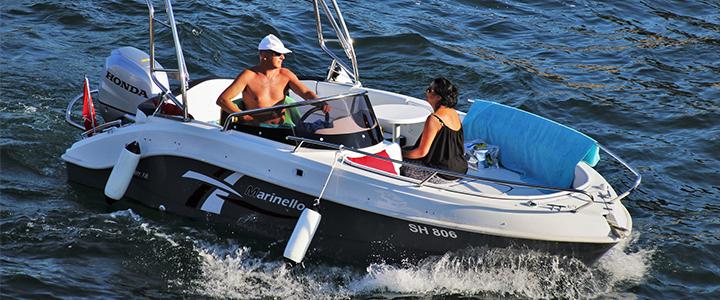
July 2021: Lake Etiquette: It’s Not ‘Whatever Floats Your Boat’
New Hampshire’s beautiful lakes, ponds and rivers play host to a large number of recreational motor boats as Granite Staters and visitors get out on the water for fishing, water skiing, tubing and pleasure cruising. Recreational boating provides a great opportunity to enjoy our waters. However, with this comes a responsibility to protect water quality. Individual boats usually release only small amounts of pollutants but when multiplied by thousands of boaters, they can cause distinct water quality problems.
Limiting pollution from the care and usage of motor boats can promote long-term economic benefits and environmental health and help recreational boating to remain a fun-filled outdoor experience. Clean boats, clean boating habits and clean marinas benefit the entire boating community as well as aquatic life.
The main ways motor boat owners can instill good habits to protect the environment are:
- Limiting habitat and shoreline impacts by controlling wake and taking care in shallow areas. The waves generated from boat wakes can be around a foot high, sometimes more, and, if too close to shore, can contribute to slumping banks and loss of shoreline vegetation and sandy beaches. Boats can also destroy habitat for aquatic animals directly by uprooting and cutting up aquatic plants in shallow areas where motors extend down near the plant growth.
- Following boat washing and maintenance best practices to prevent wastewater and potential toxins from entering surface waters. If done without caution, these acts have the potential to contribute chemical pollutants such as solvents, paints, or oils, to the state’s surface waters.
- Ensuring there is no discharge of sewage and waste by using boat pumpouts. Sewage discharged from boats can make water unsightly and unsafe and stimulates algae growth, as well as fostering toxic algal blooms.
- Preventing the spread of aquatic invasive species. Aquatic invasive plants can lead to reduced shorefront property values, water quality impairments and problems with the aesthetic and recreational values of waterbodies. The spread of these plants occur when boats and bilges are not properly cleaned between trips.
The following are some best practices to minimize or prevent negative impacts in these four areas. For more details about all of these activities, see the links provided above.
Habitat and Shoreline Impacts
- Follow “NO WAKE” rules and guidelines.
- Avoid boating in shallow near-shore areas and marshy areas, as they are more at risk for impacts resulting from motorized boating activities.
- Do not to run the propeller or skeg against or along the bottom substrates.
- Avoid traveling through densely vegetated areas.
- Do not power load your boat onto your trailer.
Boat Washing and Maintenance
- Do not the wash or rinse water to drain directly to any surface water.
- When possible, boat washing should take place in an area that collects and sends all associated water and detergents to an approved and permitted private or public wastewater collection and treatment system.
- For individual boat owners where boat washing occurs in an area that does not drain to a wastewater collection system, all associated wash water should soak directly into the ground.
- When boat washing is taking place over dry ground, remove all drain plugs so that the water can drain out of the boat during and after the wash process.
- Carefully read the label prior to purchase of any cleaning product and review the ingredients included. Use only phosphate-free detergents. Do not use detergents containing ammonia, sodium hypochlorite (bleach), chlorinated solvents, petroleum distillates, strong acids, or lye (especially in places where they could be released to the water.)
- Consider using only water, which may actually be all you need to complete the job.
- Read more about these best practices in “Boat Washing and Engine Maintenance for Boat Owners.”
Boat Pumpouts
- Make sure you are pumping out your holding tanks regularly at pumpout stations. Check out NHDES’ map of pumpout stations in New Hampshire waters.
- Check to see that your wastewater drains to a holding tank by flushing toilets and running water in sinks and showers. Have a friend watch outside the boat to see if any water drains to the lake.
- Check all your plumbing Y-valves to ensure they are disconnected. A Y-valve is a switch that allows boats to discharge wastewater either to a holding tank or overboard. Boats on the coast often have Y-valves for offshore disposal, but these valves are not allowed in New Hampshire’s inland lakes.
- Ask a marine professional to verify that your plumbing is set up in a way that directs wastewater to the holding tank and does not discharge to the lake.
- Learn more about state law and regulations for boat sewage and waste in our boat pumpouts fact sheet.
Invasive Species
- Learn about the different species and what to look out for in this series of fact sheets about invasive species in NH.
- Learn where infestations are documented in New Hampshire on the NHDES Lake Mapper.
- Before leaving ANY boat launch area:
- CLEAN any mud, plants, animals and debris off your boat, trailer and equipment, and dispose away from the waterbody.
- DRAIN your motor, live wells, bait wells, ballast bags and tanks, and bilge areas away from the waterbody.
- DRY anything that came in contact with the water. Rinse and towel-dry all equipment or allow for five days drying time.




